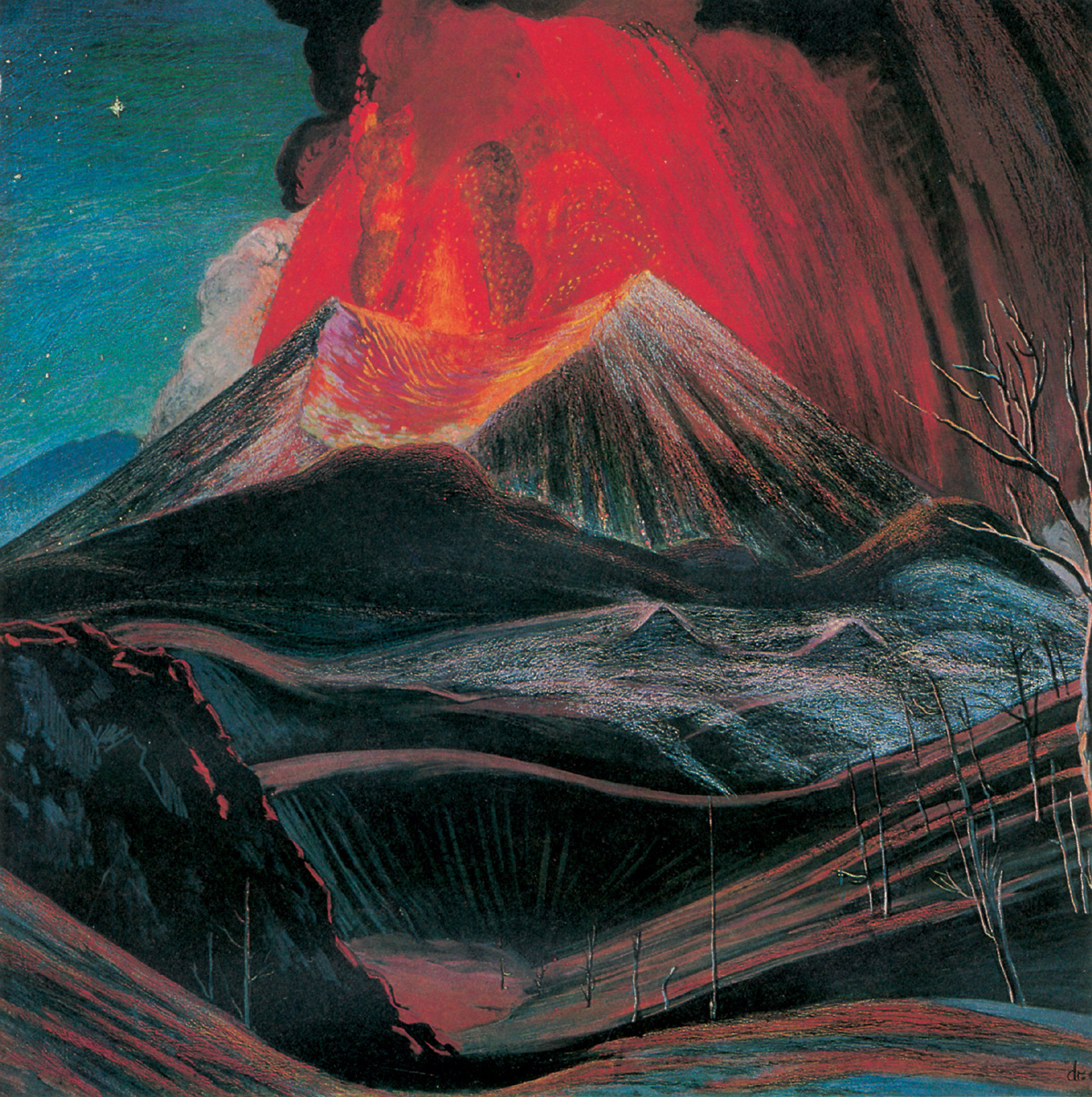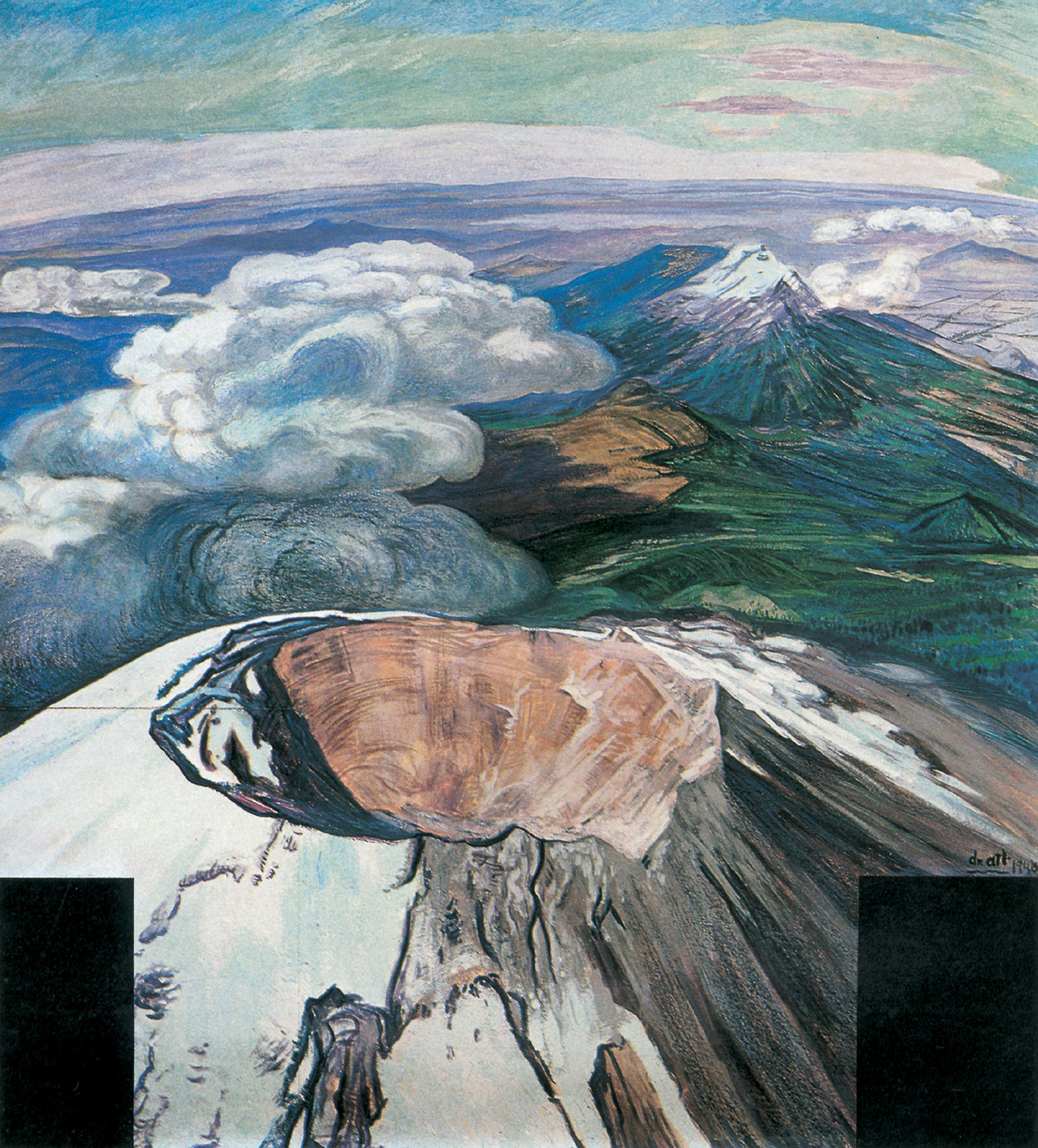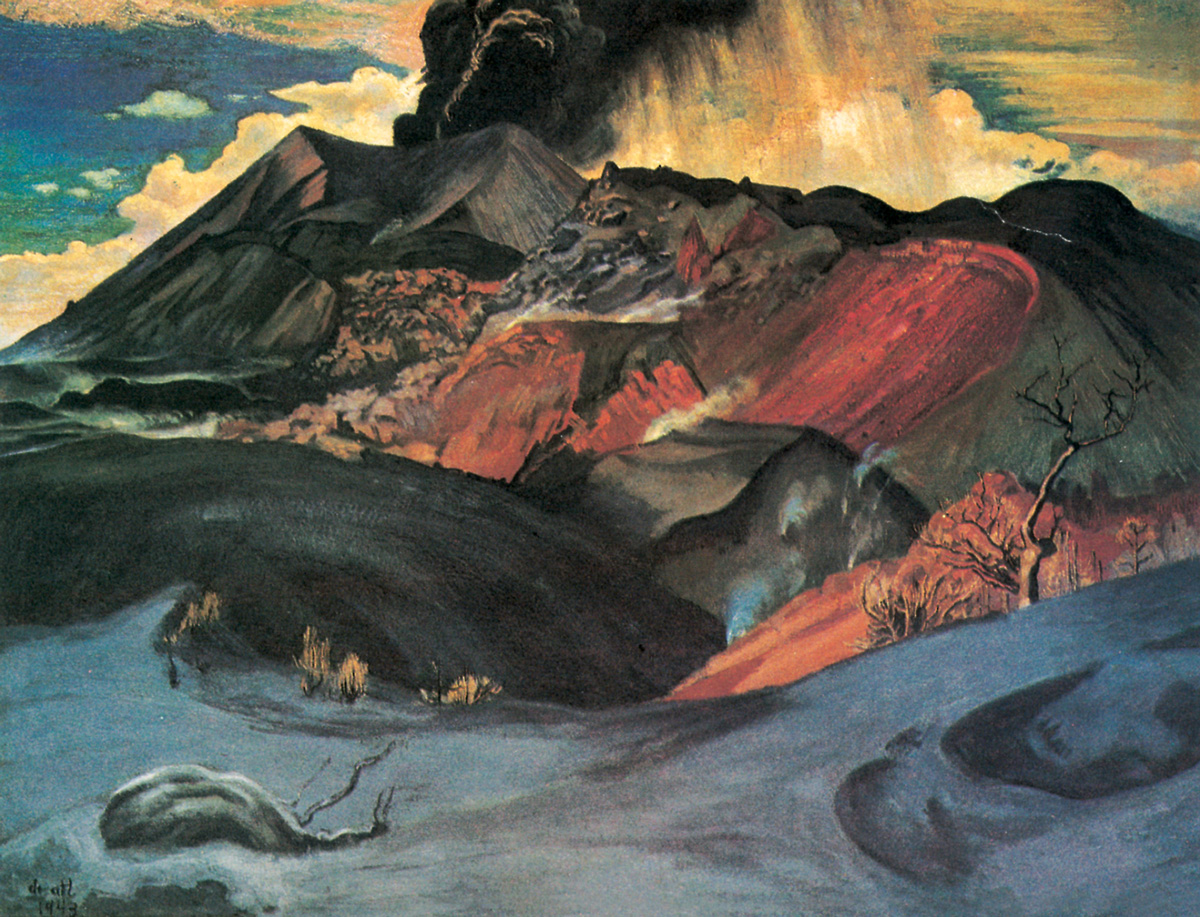The Artist as Volcano
The seismic imagination of Dr. Atl
Jesse Lerner

In February 1943, the events in a remote cornfield in Western Mexico attracted the attention of a war-weary world, which welcomed the distraction offered by this dramatic and completely unexpected phenomenon. A peasant farmer tending his crops near San Juan Parangaricutiro, Michoacán, discovered a heretofore non-existent lava outcropping in his fields. From these modest beginnings the smoking outcropping of molten matter grew in size in a matter of days to the height of an average adult, then to that of a mature tree, until an entirely new, active volcanic mountain had appeared, seemingly out of nowhere. Of the many eyewitnesses to the birth of the volcano Paricutín, none was more enthusiastic than Dr. Atl, a man whose tireless activities as a landscape painter, political commentator, statesman, novelist, poet, chef, cultural promoter, polemicist, and utopian philosopher all take a back seat to his lifelong obsession with volcanoes. In the biography of Dr. Atl, the eruption of Paricutín has another significance; it pulled the painter away from his pro-Nazi and anti-Semitic activities in Mexico, one of several extremist positions he embraced over the course of his life, diverting his attention from politics to volcanology.
Atl was born with the considerably more prosaic name of Gerardo Murillo, but at an early age he renamed himself, pairing the honorific from a self-conferred graduate degree with the Nahuatl word for water. His self-christening was a declaration of independence, severing ties with family and past, as he wrote:
I am the one who abandoned his home because of family disagreements, not that other one (Gerardo Murillo); I am the one who took part in the civil strife in Italy, Greece and Paris, not the other; I am the one who formed a part of the first Red Battalions in Mexico, before those of the Russians, and not the other; I am the one who started the artistic revolution in this country, and not the other; the one that was to be put before the firing squad in Puerto Mexico in June of 1914, and later that year in Xochimilco, and again after the disaster in Algibes was Dr. Atl and not that illustrious unknown whose name some amuse themselves by exhuming from the family burial plot … Why should I not search for my own name, given that I am in agreement neither with my kinfolk nor with the male saint under whose patronage they have placed me? The name I carry today is a direct emanation of circumstances, of my way of life and my independent spirit. I am Dr. Atl because I am Dr. Atl and all the good or bad that I have done, all that has any value, was done by me, Dr. Atl, self-baptized in the pagan manner with the marvelous water of my joy of living.[1]

Surveying the life and writings of Dr. Atl, a special challenge presents itself to any would-be biographer. Atl is a man so intent on creating and perpetuating a series of myths about himself that it is no easy matter distinguishing the facts of his nearly ninety years of seemingly ceaseless activity and his larger-than-life personality from his not-so-private fantasies. Even given the axiom that all autobiography is self-serving fiction, Atl’s accounts of his own life make for an extreme, exceptional case. He writes, for example, that while in Europe in 1900 he walked from Rome to Paris in order to visit the Universal Exposition (and to exhibit a self-portrait at the Parisian Salon, where he was awarded a silver medal), and then later that same year made “very brief visits” to Russia, England, Egypt, India, and China. Given the modes of transportation that would have been available at the time, not to mention the anti-imperial upheaval that had just overtaken China, one is compelled to dismiss at least some of this account as fiction. Nonetheless, through both the review of his artworks and the skeptical scrutiny of his writings, it is possible to outline his accomplishments and to distinguish these from his self-aggrandizing inventions. Making sense of the multiple contradictions of Atl’s life is more challenging; how is it that the same author is responsible for the careful empiricism of his volcanological texts and the considerably more speculative—not to say frivolous—writings like Un grito en la Atlántida, which advances the thesis that the inhabitants of Atlantis spoke Nahuatl? How does one reconcile his leadership role in the “Red Battalions” and the Wobbly-influenced House of the International Worker during the Mexican Revolution with his rabid anti-communist and pro-Nazi writings from the Second World War? The answers are at best partial. At least part of Atl’s support for Hitler seems to be based, improbably enough, on their shared interest in painting. He wrote:
I have read in various English and French periodicals some writers’ mocking criticisms of Hitler’s background in art. They know not of what they speak. The painter has, above other social types, the enormous superiority of his clear vision of things … Painters are the ones most qualified to govern and to create a society completely different from those that have previously existed. Hitler is the confirmation of this theory.[2]
In the light of these thoughts, Atl’s unrealized designs for the utopian city called Olinka, centered on an inconceivably tall cylindrical skyscraper populated by artists and scientists, reveals itself as an elitist retreat for the would-be Übermensch rather than egalitarian paradise reflecting the leftist activities of his youth.[3] Dr. Atl’s is a life of contradictions and passions, of epic journeys undertaken on foot (even after the amputation of his right leg) and explosive personal relationships.
Within the history of Mexican art, Atl deserves a place as much for his pedagogical service as for his volcanic landscapes, portraits, and other paintings. At the beginning of the twentieth century, on the eve of the Mexican Revolution, education at the venerable San Carlos Academy, the school of the arts in Mexico City, remained mired in academicism and insulated from the innovations of modern art. While the various -isms of modern painting transformed the arts of Paris and elsewhere, students at San Carlos continued to diligently copy plaster casts of Classical sculptures and old master prints, much as they had been doing for over a century. Frustration with this rigid academicism, a growing desire for reform, and unfulfilled promises for change all contributed to the student unrest.[4] One section of this opposition to the dominant academicism was led by the symbolists, but Atl’s dissenting voice was a distinctive one, championing post-Impressionism and vividly evoking his impressions of Europe to the art students. Among these students was José Clemente Orozco, who writes in his autobiography:
Not long after this I met Atl in the Academy. He had a studio there, and he used to visit with us in the painting rooms and the night classes. While we were copying he would entertain us, speaking in his easy, insinuating, enthusiastic tone of his travels in Europe and his stay in Rome. When he spoke of the Sistine Chapel and of Leonardo his voice took fire. The great mural paintings![5]Orozco credits Atl’s with the role of a catalyst for the Mexican muralist movement:
In these night watches of apprentice painters the first signs of revolution appeared in Mexican art. The Mexican had been a poor colonial servant, incapable of creating or thinking for himself; everything had to be imported readymade from European centers, for we were an inferior and degenerate race. They let us paint, but we had to paint the way they did in Paris, and it was the Parisian critic who would pass upon the result and pronounce the final verdict … In the nightly sessions in the Academy, as we listened to the fervent voice of that agitator Dr. Atl, we began to suspect that the whole colonial situation was nothing but a swindle foisted upon us by international traders. We too had a character, which was quite the equal of any other. We would learn what the ancients and the foreigners could teach us, but we could do as much as they, or more. It was not pride but self-confidence that moved us to this belief, a sense of our own being and our destiny.[6]

Several years later, with the country now deep in the throes of the Revolution, Atl returned from a second European visit and briefly served as director of the San Carlos Academy. His tumultuous term was marked by efforts to enlist the students’ talents and energies in the revolutionary project, efforts interrupted when Constitutionalist government of General Venustiano Carranza had to abandon the capital city to the troops of Villa and Zapata, and take temporary refuge in Veracruz.
Atl’s contributions to Mexican visual arts went beyond his administrative and promotional roles. As a champion of Mexican handicrafts, he led the post-Revolutionary, nationalist campaign for greater recognition of popular styles and a local, folk aesthetic. He invented a new drawing medium, a kind of pastel-like crayon still manufactured today, which he named after himself: Atlcolors. He also proposed what he identified as a new genre of painting, which he dubbed with the neologism aerolandscape (or in Spanish: aeropaisaje). As early as 1922 he had sketched the volcano of Popocatépetl from above while traveling in an airplane. In 1958, at the age of 83, following a period of work done in helicopters and airplanes lent by friendly politicians, he wrote a manifesto entitled “A New Genre of Painting: The Aerolandscape” (“Un nuevo genero de pintura: el aeropaisaje”), which declares, in the spirit of a latter-day Futurist, that “the aerolandscape is the tumult of the skies and of the land converted into a rhythmic beauty in the conscience of man.”[7] In these paintings, the horizon distorts at the canvas’s edges as if viewed through a fish-eye lens, suggesting that the curvature of the planet itself had come into view. Months before his death he drafted a proposal for an exhibition of aerolandscapes from the entire American hemisphere, but he passed away before completing this project.
Atl’s volcanic landscapes were derived from extended periods of fieldwork and observation. A passionate hiker, he would spend weeks or months on these rocky peaks, sketching, writing, and painting. The process at times involved considerable dangers, as he describes in his book on Paricutín:
Returning to my little camp, step by step, admiring the volcano’s solemn southern side, the earth shook, and amid detonations the base of the cone, next to the great dark lump, sprouted bouquets of fire wrapped in clouds of dust. A river of lava ran down towards me. The heat suffocated me. I wanted to flee, but my legs refused to move. Clinging to a little trunk of an oak I felt myself burn. There was nothing left to do but to look before dying. The wide river of lava hurled down a cascade, while from the igneous fountain surged an enormous whirlpool of thick red flames, as other whirlpools of dust accompanied it in a fantastic dance. The burning column extended its high point into the shape of a cloud. I thought vaguely of running, but I could not move. My arms were slipping from the trunk of the little tree, and I should have fallen onto the ground. Unexpectedly the west wind pushed the dust, flames and heat along the base of the cone. I could breathe and recover my senses, but I remained stuck to the ground. I waited a long while, and, a bit recovered, I got up; slowly I approached the edge of the lava, which had stopped a few meters from my camp.[8]
Atl’s literary output reflects the wide range of his interests. A preliminary review of his publications reveals four volumes of short stories, an autobiographic novel, a collection of prose poems about Mexican volcanoes, an unclassifiable philosophical science-fiction novel, a book on petroleum and another on gold, an eccentric, rabidly anticlerical novel populated with an eclectic mélange of historical characters, the aforementioned speculative tract on Atlantis, two studies of volcanoes, catalogue essays on popular Mexican arts and colonial architecture, an essay on landscape painting, and numerous political writings. But further research in the National Library’s Atl archive tells of an even broader scope of pursuits. His plans for an open-air museum in Mexico City’s Chapultepec Park would have surely made a welcome addition to the city. Not one to shy away from embarking on large-scale projects in disciplines where he had no training or experience, he proposed an even more ambitious redesign of Central Mexico City, an enormous exercise in urban planning that, like the open-air museum, remained on the drawing board. Evoking the support Baron Hausmann received from Napoleon III, Atl lamented the absence of a strong, autocratic leader who could make these dreams a reality: “The first thing needed to solve the multiple and complicated problems of the capital is a dictator.”[9] Though the ends sought do not justify the desired means, Atl’s arguments for urban planning are all the more relevant in a city as chaotic and dysfunctional as today’s Mexico City. As problematic as some of Atl’s proposals may be, Diego Rivera was undoubtedly right when he pronounced that “Dr. Atl is one of the most curious personalities born to the modern New World—his story is the most picturesque of all the painters, impossible to recount in fewer than several volumes.”[10]
- Included in Homenaje del pueblo y del gobierno de Jalisco al pintor Gerardo Murillo, “Dr. Atl,” en el primer aniversario de su fallecimiento (Guadalajara: Gobierno del Estado de Jalisco, Instituto Jalissciense de Bellas Artes, 1965), pp. 7–8. Translation mine.
- Dr, Atl, Quiénes ganarán la Guerra? (Mexico City, 1940), pp. 4–5. Translation mine.
- For more on Olinka, see Mario Brant, “Dr. Atl,” Américas vol. 17, no. 9 (1965), p. 37; as well as Cuauhtémoc Medina, “El espejo celeste” Mandorla, no. 2 (Spring 1992), pp. 197–219.
- This history is summarized in Jean Charlot, Mexican Art and the Academy of San Carlos, 1785–1915 (Austin: University of Texas Press, 1962).
- José Clemente Orozco, An Autobiography, trans. Robert C. Stephenson (Austin: University of Texas Press, 1962), p. 16.
- Ibid., pp. 19–20.
- A copy of this manifesto, Un nuevo genero de pintura: el aeropaisaje, is found in the Fondo Atl in Mexico City’s Biblioteca Nacional.
- Dr. Atl, ¿Cómo nace y crece un vocan? El Paricutín (Mexico City: Editorial Stylo, 1950), pp. 59–60. Translation mine.
- From an unpublished manuscript in the Atl archive, Planificación urbana, un antecedente importante y una proposición lógica. Translation mine.
- Included in Homenaje del pueblo, p. 19. Translation mine.
Jesse Lerner, an editor-at-large at Cabinet, is a documentary filmmaker based in Los Angeles. He is the co-programmer of this year’s Robert Flaherty Seminar.
Spotted an error? Email us at corrections at cabinetmagazine dot org.
If you’ve enjoyed the free articles that we offer on our site, please consider subscribing to our nonprofit magazine. You get twelve online issues and unlimited access to all our archives.